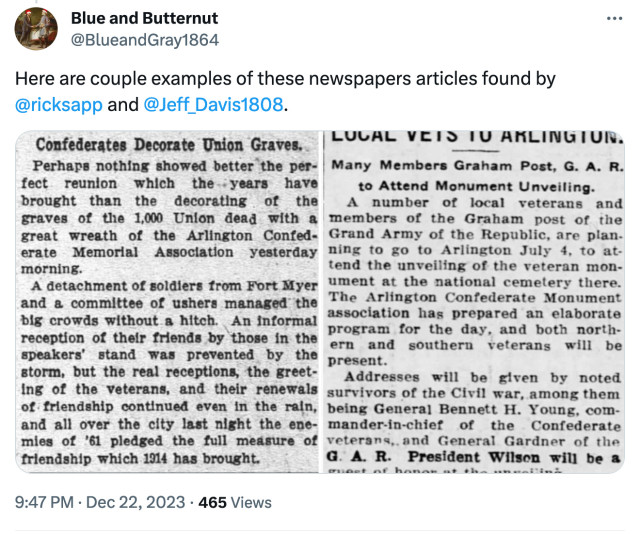Defenders of the Confederate memorial in Arlington National Cemetery staked their defense on the belief that the memorial represents reconciliation. In fact, a number of people referred to it specifically as the “Reconciliation Monument.” As I have pointed out on numerous occasions, no one referred to it officially as such, including the United Daughters of the Confederacy, who were responsible for its dedication.
People posted newspaper clippings to demonstrate this good will between former enemies in 1914. But in doing so they highlighted their inability to critically evaluate primary sources. What follows is a cautionary tale of getting your history from un-vetted sources
Here is an example of what I mean from Twitter X.

Here is another example from the same Twitter X account. This time it’s the famous photograph of Confederate and Union veterans shaking hands during the 50th anniversary of the battle of Gettysburg in 1913.

It's an iconic photograph and for many people it is the clearest example of the good will that former veterans on both sides had for one another. Forgive & forget.
But as historian Thomas Flagel argues, the veterans' primary intention was not to embrace reconciliation at Gettysburg. Many of them remained deeply bitter and were driven by feelings of sectionalism. Most veterans went to Gettysburg, according to Flagel, not to shake hands, but to relive their own experiences. Photographs like the one above were often orchestrated and sometimes difficult to achieve because of these lingering feelings of bitterness.
What this individual has done is little more than cut and paste a couple of primary sources onto Twitter X without any attempt at interpretation. It’s as if the primary sources speak for themselves. No need to know anything other than the words on the page. Let’s be clear, this isn’t doing history.
They fail to evaluate these sources within the rich archive that exists on the subject of reconciliation and also ignore the rich historical scholarship that helps to place these primary sources in context. No references to historians such as Karen Cox, Caroline Janney, David Blight, Keith Harris, and Barbara Gannon. Why? Because they haven’t read them.